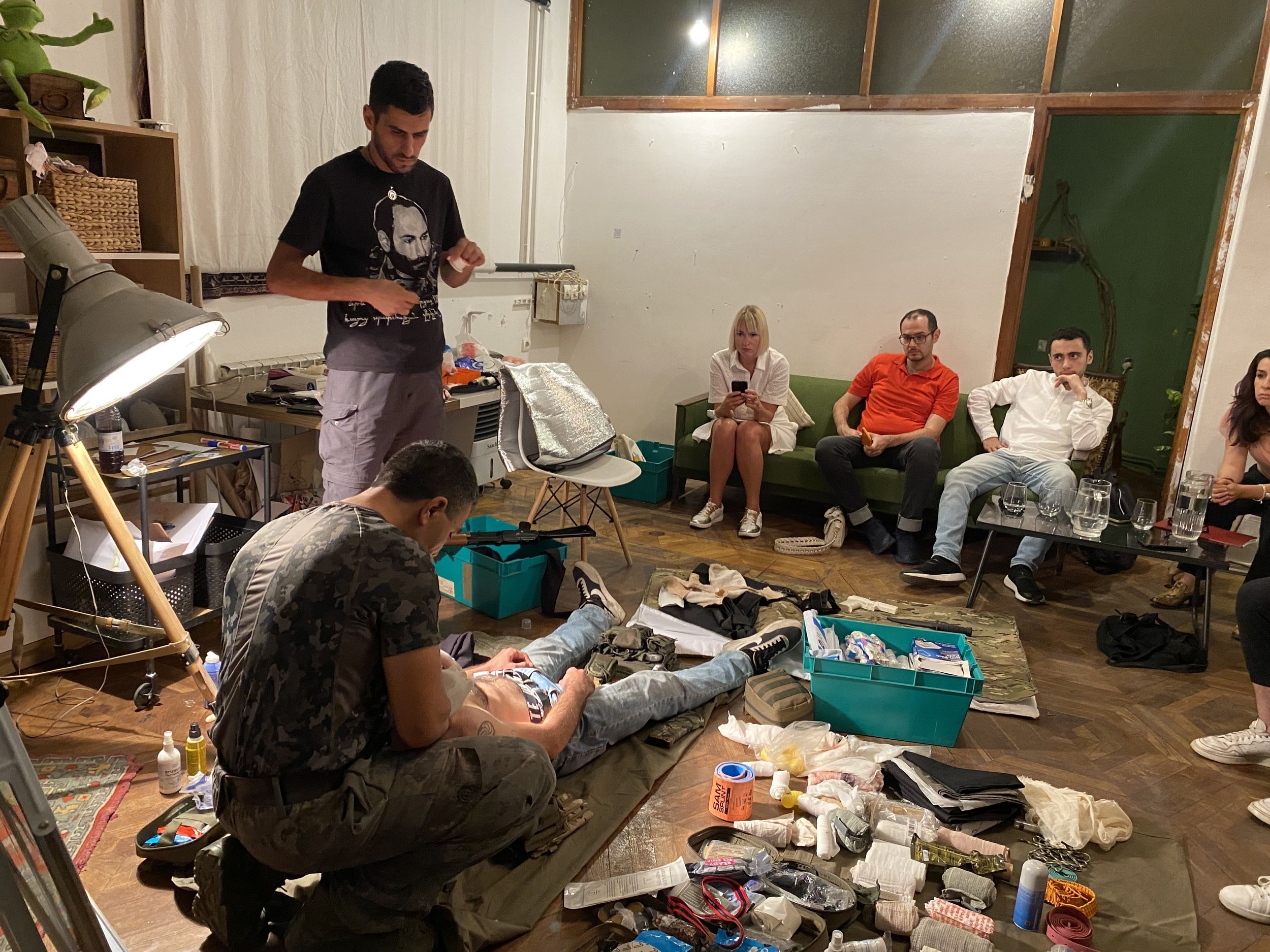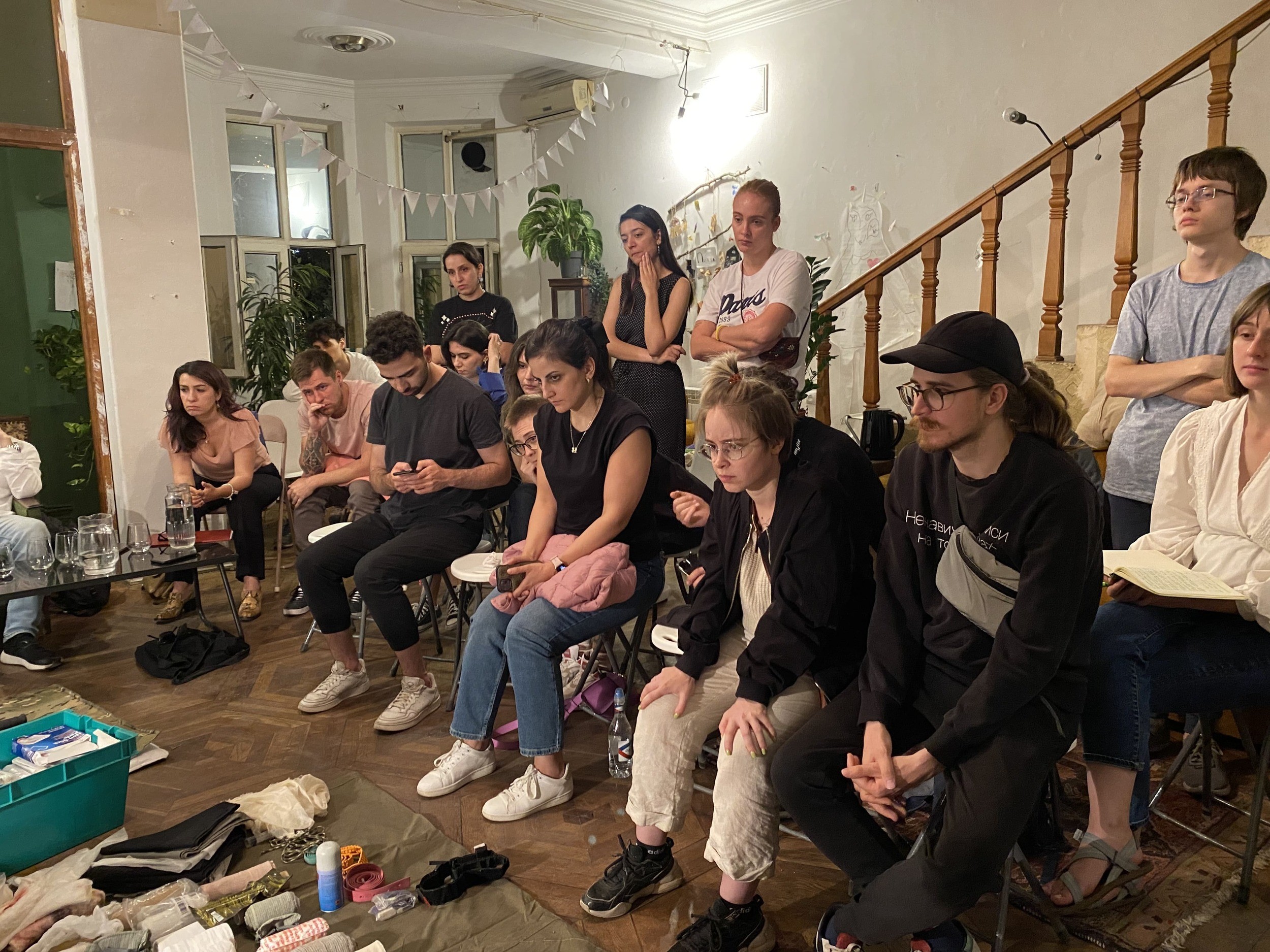For those living in conflict-prone and disaster-prone regions, first aid is an invaluable skill. Not only is the opportunity to save another person’s life important, but also the psychological effect of preparedness: even if you don’t have to put the knowledge into practice, you will feel more confident and calm.
In this article we will list the basic principles and steps of first aid (non-medical). We learned about them in September 2022 while taking courses from Komandos Razmamarzakan Akumb and Ashot Topuzyan – specialists in military training and basic life safety. However, it is much more effective to attend such special courses. We recommend classes from foundations VIVA and VOMA. In the near future, Move2Armenia will repeat last year's first aid courses. Follow the news on our social networks.
Contents
- Basic principles
- Instructions: 5 steps
- Five “NO”: how not to harm yourself and the victim
- What's next?
Basic principles
The most important thing is the willingness to provide first aid. The bystander effect is deadly: don't count on anyone else to help. If you have the skills and knowledge, you are relatively safe, toughen yourself psychologically and take action.
In any emergency situation, you need to put yourself first and first make sure that you do not need first aid or that your life is not in direct danger. It is impossible to help another if your health is in critical condition.. Once you are sure that you are able to provide first aid, remain cool and calm. Panic can be more dangerous than building debris and shrapnel - you can harm yourself or the victim. Address the person in a soothing, positive tone. Don't point out assumptions or facts about the condition to him or her, and definitely don't make pessimistic predictions. The best formulation is “Everything will be fine, we called an ambulance / we’ll get you out.”
Don't make things worse for the victim (and yourself). Rubber gloves and a mask are necessary, otherwise there is a risk of transmitting harmful bacteria to the victim or becoming infected yourself. If assistance is provided to a combatant, do not forget that soldiers have hygiene products in their tactical first aid kit, primarily gloves.

Photo: Akshova Anastasia
If you are in a combat zone, remember danger levels: red, yellow and green.
- Red alert is an active combat zone. Here the victim needs to be given only basic assistance, stop blood loss and bring him to the yellow zone.
- The yellow zone is a trench, shelter, or other place where there is no active combat. Here a secondary examination of the victim is carried out: careful bandaging, loosening of tourniquets that are too tight in case of blood loss. The wounded man is preparing to be transported to the green zone.
- The green zone is a hospital, a hospital where assistance is provided by experienced doctors.
Instructions: 5 steps
First step: In parallel with other actions, call emergency services or, if this is not possible, shout for someone to call.
Second step: inspection of the area to determine the level of safety. This will help you understand what kind of help and to what extent can be provided right now, and whether the victim can be moved.
Third step: examination of the victim. Assess the condition and nature of the victim’s injuries. Unfortunately, he or she may already be dead. When in doubt, be sure to check, otherwise you could waste extra time that others need or put your life in danger. How to check if a person is alive:
- The fastest and most well-known way is to shine a light into the pupil: if it dilates, the victim is alive.
- Check your pulse.
- By holding the phone/mirror to the victim’s mouth, you can tell by the presence of condensation (perspiration) whether he is breathing or not. If he is not breathing, but a pulse or pupil reaction is observed, first of all it is necessary to carry out artificial respiration (in parallel with other processes).
Fourth step: help the victim. Next you need to understand the nature of the damage and provide appropriate assistance:
- stop bleeding in any way possible;
- in case of a fracture, immobilize the limb;
- in case of fainting, turn the patient over and thus unblock the airways;
- in case of cardiac arrest, perform artificial cardiac massage. Please note that it is only effective when artificial respiration is performed in parallel.
Photo: Akshova Anastasia
Fifth step: re-inspection. After primary aid or moving the victim from the red zone, it is highly advisable to conduct a re-examination. Remember that the most obvious injuries are often hidden by secondary, but equally lethal ones. For example, the victim may still be bleeding when recovering from fainting.
Five “NO”: how not to harm yourself and the victim
- Do not move your body. Only in case of imminent danger (shelling, building collapse) can the victim be moved. Otherwise, this carries the risk of causing additional damage to him and aggravating the situation.
- Do not “fix” the victim. If something falls out of your body, do not try to push it back. Also, do not set fractures or under any circumstances try to remove shrapnel, bullets or other foreign objects. Doing so may lead to infection or increased bleeding.
- Do not give any medications. This is the task of doctors. The only exception is if the victim has medicine with him and is able to take it. Give the drug to the hand so that the owner can use it himself.
- Do not “pull” you out of fainting. Fainting is a protective reaction of the body. Position your body so that there is access to air. Do not give water: in some cases this will make the situation worse.
- Do not leave the area with the victim. Until help arrives, do not move away from the victim. The only exception is that if your life is in danger, you will have to leave the victim and move to a safer place.
What's next?
We hope that the article was useful to you. However, the best solution is to take first aid courses: they are more visual and detailed. Let us repeat that we recommend classes from foundations VIVA and VOMA. We will definitely inform you when we resume our courses. And how they took place in September 2022, you can see at this and this link.
Photo: Akshova Anastasia




















Add a comment